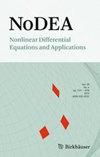求助PDF
{"title":"具有时变积分的抛物型方程的有界斜率条件","authors":"Leah Schätzler, Jarkko Siltakoski","doi":"10.1007/s00030-023-00876-6","DOIUrl":null,"url":null,"abstract":"Abstract In this paper, we study the Cauchy–Dirichlet problem $$\\begin{aligned} \\left\\{ \\begin{array}{ll} \\partial _t u - {\\text {div}} \\left( D_\\xi f(t, Du)\\right) = 0 &{} \\quad \\hbox {in} \\ \\Omega _T, \\\\ u = u_o &{} \\quad \\hbox { on} \\ \\partial _{\\mathcal {P}} \\Omega _T,\\\\ \\end{array} \\right. \\end{aligned}$$ <mml:math xmlns:mml=\"http://www.w3.org/1998/Math/MathML\"> <mml:mrow> <mml:mtable> <mml:mtr> <mml:mtd> <mml:mfenced> <mml:mrow> <mml:mtable> <mml:mtr> <mml:mtd> <mml:mrow> <mml:msub> <mml:mi>∂</mml:mi> <mml:mi>t</mml:mi> </mml:msub> <mml:mi>u</mml:mi> <mml:mo>-</mml:mo> <mml:mtext>div</mml:mtext> <mml:mfenced> <mml:msub> <mml:mi>D</mml:mi> <mml:mi>ξ</mml:mi> </mml:msub> <mml:mi>f</mml:mi> <mml:mrow> <mml:mo>(</mml:mo> <mml:mi>t</mml:mi> <mml:mo>,</mml:mo> <mml:mi>D</mml:mi> <mml:mi>u</mml:mi> <mml:mo>)</mml:mo> </mml:mrow> </mml:mfenced> <mml:mo>=</mml:mo> <mml:mn>0</mml:mn> </mml:mrow> </mml:mtd> <mml:mtd> <mml:mrow> <mml:mrow /> <mml:mspace /> <mml:mtext>in</mml:mtext> <mml:mspace /> <mml:msub> <mml:mi>Ω</mml:mi> <mml:mi>T</mml:mi> </mml:msub> <mml:mo>,</mml:mo> </mml:mrow> </mml:mtd> </mml:mtr> <mml:mtr> <mml:mtd> <mml:mrow> <mml:mrow /> <mml:mi>u</mml:mi> <mml:mo>=</mml:mo> <mml:msub> <mml:mi>u</mml:mi> <mml:mi>o</mml:mi> </mml:msub> </mml:mrow> </mml:mtd> <mml:mtd> <mml:mrow> <mml:mrow /> <mml:mspace /> <mml:mspace /> <mml:mtext>on</mml:mtext> <mml:mspace /> <mml:msub> <mml:mi>∂</mml:mi> <mml:mi>P</mml:mi> </mml:msub> <mml:msub> <mml:mi>Ω</mml:mi> <mml:mi>T</mml:mi> </mml:msub> <mml:mo>,</mml:mo> </mml:mrow> </mml:mtd> </mml:mtr> </mml:mtable> </mml:mrow> </mml:mfenced> </mml:mtd> </mml:mtr> </mml:mtable> </mml:mrow> </mml:math> where $$\\Omega \\subset \\mathbb {R}^n$$ <mml:math xmlns:mml=\"http://www.w3.org/1998/Math/MathML\"> <mml:mrow> <mml:mi>Ω</mml:mi> <mml:mo>⊂</mml:mo> <mml:msup> <mml:mrow> <mml:mi>R</mml:mi> </mml:mrow> <mml:mi>n</mml:mi> </mml:msup> </mml:mrow> </mml:math> is a convex and bounded domain, $$f:[0,T]\\times {\\mathbb {R}}^n \\rightarrow {\\mathbb {R}}$$ <mml:math xmlns:mml=\"http://www.w3.org/1998/Math/MathML\"> <mml:mrow> <mml:mi>f</mml:mi> <mml:mo>:</mml:mo> <mml:mrow> <mml:mo>[</mml:mo> <mml:mn>0</mml:mn> <mml:mo>,</mml:mo> <mml:mi>T</mml:mi> <mml:mo>]</mml:mo> </mml:mrow> <mml:mo>×</mml:mo> <mml:msup> <mml:mrow> <mml:mi>R</mml:mi> </mml:mrow> <mml:mi>n</mml:mi> </mml:msup> <mml:mo>→</mml:mo> <mml:mi>R</mml:mi> </mml:mrow> </mml:math> is $$L^1$$ <mml:math xmlns:mml=\"http://www.w3.org/1998/Math/MathML\"> <mml:msup> <mml:mi>L</mml:mi> <mml:mn>1</mml:mn> </mml:msup> </mml:math> -integrable in time and convex in the second variable. Assuming that the initial and boundary datum $$u_o:{\\overline{\\Omega }}\\rightarrow {\\mathbb {R}}$$ <mml:math xmlns:mml=\"http://www.w3.org/1998/Math/MathML\"> <mml:mrow> <mml:msub> <mml:mi>u</mml:mi> <mml:mi>o</mml:mi> </mml:msub> <mml:mo>:</mml:mo> <mml:mover> <mml:mi>Ω</mml:mi> <mml:mo>¯</mml:mo> </mml:mover> <mml:mo>→</mml:mo> <mml:mi>R</mml:mi> </mml:mrow> </mml:math> satisfies the bounded slope condition, we prove the existence of a unique variational solution that is Lipschitz continuous in the space variable.","PeriodicalId":49747,"journal":{"name":"Nodea-Nonlinear Differential Equations and Applications","volume":"22 1","pages":"0"},"PeriodicalIF":1.2000,"publicationDate":"2023-09-12","publicationTypes":"Journal Article","fieldsOfStudy":null,"isOpenAccess":false,"openAccessPdf":"","citationCount":"0","resultStr":"{\"title\":\"The bounded slope condition for parabolic equations with time-dependent integrands\",\"authors\":\"Leah Schätzler, Jarkko Siltakoski\",\"doi\":\"10.1007/s00030-023-00876-6\",\"DOIUrl\":null,\"url\":null,\"abstract\":\"Abstract In this paper, we study the Cauchy–Dirichlet problem $$\\\\begin{aligned} \\\\left\\\\{ \\\\begin{array}{ll} \\\\partial _t u - {\\\\text {div}} \\\\left( D_\\\\xi f(t, Du)\\\\right) = 0 &{} \\\\quad \\\\hbox {in} \\\\ \\\\Omega _T, \\\\\\\\ u = u_o &{} \\\\quad \\\\hbox { on} \\\\ \\\\partial _{\\\\mathcal {P}} \\\\Omega _T,\\\\\\\\ \\\\end{array} \\\\right. \\\\end{aligned}$$ <mml:math xmlns:mml=\\\"http://www.w3.org/1998/Math/MathML\\\"> <mml:mrow> <mml:mtable> <mml:mtr> <mml:mtd> <mml:mfenced> <mml:mrow> <mml:mtable> <mml:mtr> <mml:mtd> <mml:mrow> <mml:msub> <mml:mi>∂</mml:mi> <mml:mi>t</mml:mi> </mml:msub> <mml:mi>u</mml:mi> <mml:mo>-</mml:mo> <mml:mtext>div</mml:mtext> <mml:mfenced> <mml:msub> <mml:mi>D</mml:mi> <mml:mi>ξ</mml:mi> </mml:msub> <mml:mi>f</mml:mi> <mml:mrow> <mml:mo>(</mml:mo> <mml:mi>t</mml:mi> <mml:mo>,</mml:mo> <mml:mi>D</mml:mi> <mml:mi>u</mml:mi> <mml:mo>)</mml:mo> </mml:mrow> </mml:mfenced> <mml:mo>=</mml:mo> <mml:mn>0</mml:mn> </mml:mrow> </mml:mtd> <mml:mtd> <mml:mrow> <mml:mrow /> <mml:mspace /> <mml:mtext>in</mml:mtext> <mml:mspace /> <mml:msub> <mml:mi>Ω</mml:mi> <mml:mi>T</mml:mi> </mml:msub> <mml:mo>,</mml:mo> </mml:mrow> </mml:mtd> </mml:mtr> <mml:mtr> <mml:mtd> <mml:mrow> <mml:mrow /> <mml:mi>u</mml:mi> <mml:mo>=</mml:mo> <mml:msub> <mml:mi>u</mml:mi> <mml:mi>o</mml:mi> </mml:msub> </mml:mrow> </mml:mtd> <mml:mtd> <mml:mrow> <mml:mrow /> <mml:mspace /> <mml:mspace /> <mml:mtext>on</mml:mtext> <mml:mspace /> <mml:msub> <mml:mi>∂</mml:mi> <mml:mi>P</mml:mi> </mml:msub> <mml:msub> <mml:mi>Ω</mml:mi> <mml:mi>T</mml:mi> </mml:msub> <mml:mo>,</mml:mo> </mml:mrow> </mml:mtd> </mml:mtr> </mml:mtable> </mml:mrow> </mml:mfenced> </mml:mtd> </mml:mtr> </mml:mtable> </mml:mrow> </mml:math> where $$\\\\Omega \\\\subset \\\\mathbb {R}^n$$ <mml:math xmlns:mml=\\\"http://www.w3.org/1998/Math/MathML\\\"> <mml:mrow> <mml:mi>Ω</mml:mi> <mml:mo>⊂</mml:mo> <mml:msup> <mml:mrow> <mml:mi>R</mml:mi> </mml:mrow> <mml:mi>n</mml:mi> </mml:msup> </mml:mrow> </mml:math> is a convex and bounded domain, $$f:[0,T]\\\\times {\\\\mathbb {R}}^n \\\\rightarrow {\\\\mathbb {R}}$$ <mml:math xmlns:mml=\\\"http://www.w3.org/1998/Math/MathML\\\"> <mml:mrow> <mml:mi>f</mml:mi> <mml:mo>:</mml:mo> <mml:mrow> <mml:mo>[</mml:mo> <mml:mn>0</mml:mn> <mml:mo>,</mml:mo> <mml:mi>T</mml:mi> <mml:mo>]</mml:mo> </mml:mrow> <mml:mo>×</mml:mo> <mml:msup> <mml:mrow> <mml:mi>R</mml:mi> </mml:mrow> <mml:mi>n</mml:mi> </mml:msup> <mml:mo>→</mml:mo> <mml:mi>R</mml:mi> </mml:mrow> </mml:math> is $$L^1$$ <mml:math xmlns:mml=\\\"http://www.w3.org/1998/Math/MathML\\\"> <mml:msup> <mml:mi>L</mml:mi> <mml:mn>1</mml:mn> </mml:msup> </mml:math> -integrable in time and convex in the second variable. Assuming that the initial and boundary datum $$u_o:{\\\\overline{\\\\Omega }}\\\\rightarrow {\\\\mathbb {R}}$$ <mml:math xmlns:mml=\\\"http://www.w3.org/1998/Math/MathML\\\"> <mml:mrow> <mml:msub> <mml:mi>u</mml:mi> <mml:mi>o</mml:mi> </mml:msub> <mml:mo>:</mml:mo> <mml:mover> <mml:mi>Ω</mml:mi> <mml:mo>¯</mml:mo> </mml:mover> <mml:mo>→</mml:mo> <mml:mi>R</mml:mi> </mml:mrow> </mml:math> satisfies the bounded slope condition, we prove the existence of a unique variational solution that is Lipschitz continuous in the space variable.\",\"PeriodicalId\":49747,\"journal\":{\"name\":\"Nodea-Nonlinear Differential Equations and Applications\",\"volume\":\"22 1\",\"pages\":\"0\"},\"PeriodicalIF\":1.2000,\"publicationDate\":\"2023-09-12\",\"publicationTypes\":\"Journal Article\",\"fieldsOfStudy\":null,\"isOpenAccess\":false,\"openAccessPdf\":\"\",\"citationCount\":\"0\",\"resultStr\":null,\"platform\":\"Semanticscholar\",\"paperid\":null,\"PeriodicalName\":\"Nodea-Nonlinear Differential Equations and Applications\",\"FirstCategoryId\":\"1085\",\"ListUrlMain\":\"https://doi.org/10.1007/s00030-023-00876-6\",\"RegionNum\":4,\"RegionCategory\":\"数学\",\"ArticlePicture\":[],\"TitleCN\":null,\"AbstractTextCN\":null,\"PMCID\":null,\"EPubDate\":\"\",\"PubModel\":\"\",\"JCR\":\"Q2\",\"JCRName\":\"MATHEMATICS, APPLIED\",\"Score\":null,\"Total\":0}","platform":"Semanticscholar","paperid":null,"PeriodicalName":"Nodea-Nonlinear Differential Equations and Applications","FirstCategoryId":"1085","ListUrlMain":"https://doi.org/10.1007/s00030-023-00876-6","RegionNum":4,"RegionCategory":"数学","ArticlePicture":[],"TitleCN":null,"AbstractTextCN":null,"PMCID":null,"EPubDate":"","PubModel":"","JCR":"Q2","JCRName":"MATHEMATICS, APPLIED","Score":null,"Total":0}
引用次数: 0
引用
批量引用
The bounded slope condition for parabolic equations with time-dependent integrands
Abstract In this paper, we study the Cauchy–Dirichlet problem $$\begin{aligned} \left\{ \begin{array}{ll} \partial _t u - {\text {div}} \left( D_\xi f(t, Du)\right) = 0 &{} \quad \hbox {in} \ \Omega _T, \\ u = u_o &{} \quad \hbox { on} \ \partial _{\mathcal {P}} \Omega _T,\\ \end{array} \right. \end{aligned}$$ ∂ t u - div D ξ f ( t , D u ) = 0 in Ω T , u = u o on ∂ P Ω T , where $$\Omega \subset \mathbb {R}^n$$ Ω ⊂ R n is a convex and bounded domain, $$f:[0,T]\times {\mathbb {R}}^n \rightarrow {\mathbb {R}}$$ f : [ 0 , T ] × R n → R is $$L^1$$ L 1 -integrable in time and convex in the second variable. Assuming that the initial and boundary datum $$u_o:{\overline{\Omega }}\rightarrow {\mathbb {R}}$$ u o : Ω ¯ → R satisfies the bounded slope condition, we prove the existence of a unique variational solution that is Lipschitz continuous in the space variable.

 求助内容:
求助内容: 应助结果提醒方式:
应助结果提醒方式:


